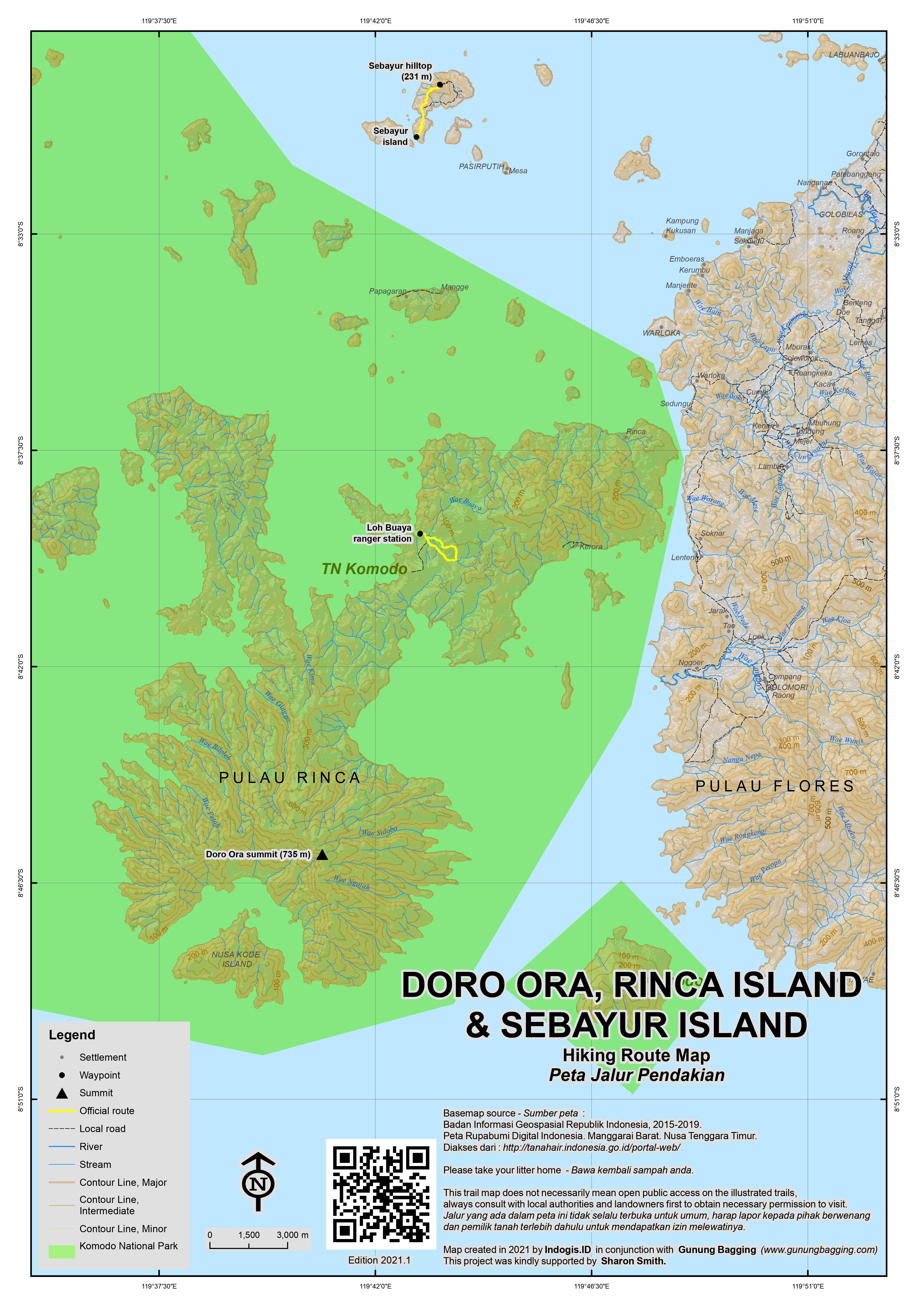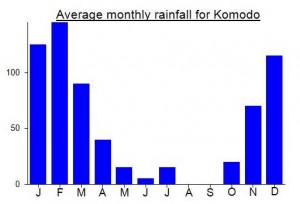Facts
- Elevation: 735 m (2,411 ft)
- Prominence: 735 m
- Ribu category: Spesial
- Province: Nusa Tenggara Timur
- Google Earth: kml
- Rating:
- Other names: none
Photos
Bagging It!
Doro Ora is the highest point of Rinca island (pronounced ‘Rintja’) – one of the two large islands in Komodo National Park. Closer than Komodo to the port town of Labuan Bajo on the western end of Flores, it is separated by the narrow Molo Strait (Selat Molo) which is less than one kilometre across at its narrowest.
Rinca is home to the second largest population of Komodo dragons after Komodo lsland itself, with estimates ranging from around 1,000 to 1,500 individuals. The dragons on Rinca island are smaller and supposedly more aggressive than those found on Komodo island. Given that Komodo dragons are fairly good swimmers, it is perhaps no surprise that the Rinca population is linked to the small number that can be found in the remote edge of Flores island by the Molo Strait.
Many travel agents offer tours to Rinca and neighbouring Komodo island, but in 2020 there is much uncertainty over how things will change in the coming years, given both the local and national governments’ plans to increase the entry ticket to at least $1000 USD per person and the terrible effects of the Covid-19 pandemic on the travel industry.
In October 2020, many tour operators, restaurants, homestays and other small businesses in Labuan Bajo have ceased operations as they catered mainly to international tourists who at present are not allowed to enter Indonesia. Mega-projects such as the construction of large international hotels seem to have been paused, temporarily or otherwise.
However, infrastructure work continues, with the streets of Labuan Bajo currently being given pavements, although to what extent these simply become places for local people to park their motorbikes as is common throughout Indonesia remains to be seen.
On Rinca, work is underway on a project dubbed ‘Jurassic Park’ at Loh Buaya (‘crocodile bay’) to construct an information centre, an elevated viewing deck, accommodation for staff and visitors and a renovated dock. A photograph supposedly taken on Rinca of a construction truck with workers on top meeting a Komodo dragon in an apparent ‘face-to-face stand-off’ went viral in October 2020.
Some commentators noted the similarity with the Tiananmen Square photograph taken in Beijing in 1989 when a lone protester came face-to-face with an army tank, and others called for an end to this mass construction project due to the potential harm to the natural ecosystem and Komodo dragon habitat. The government has now closed all public access to Rinca island until the end of June 2021.
Based on news reports, it seems as though the current plan is that Komodo island will be the expensive premium tourist destination for the wealthy only, and that Rinca will remain relatively affordable, but this plan could change.
As for hiking to the highest peak, Doro Ora and the surrounding area is closed to all but researchers, and it is unlikely that many have been to the top in recent decades. Some online sources state it can be hiked in a day, yet the pier and usual trailhead in Loh Buaya are up at the northern end of the island whilst Doro Ora is down in the south over ten kilometres away, so this claim seems almost certainly false.
As if the basic danger of meeting Komodo dragons on a substantial trek were not enough to put off any keen baggers, it seems that the juveniles actually live in trees for the first few years in order to avoid being eaten by the cannibalistic adults! Given that forest still exists on the summit ridge of Doro Ora, it seems likely that any attempt to reach the highest point would be incredibly foolish! Note that the juveniles’ saliva is just as poisonous as that of the adults.
The relevant Bakosurtanal map lists the peak as being 722m high with a similarly-high summit (721m) just 1 kilometre to the north-west and labelled ‘Golo Ora’. In between the two is a slightly lower peak at 714m. A proper survey would be needed to clarify which of the three is the highest.
When the island is open, tourists can do short treks in the north from Loh Buaya, typically lasting between 1 and 2 hours, and strictly accompanied by rangers at all times with their forked sticks to prevent attacks. Like Komodo Island, Rinca sees very little rainfall and the lower slopes of the island are very dry, very hot and largely lacking in shade.
Dragon attacks on Rinca Island are rare but certainly not unknown. A park ranger was attacked in 2013 when a Komodo dragon lay waiting under his desk. Luckily he escaped but his injury required specialist medical treatment in Bali followed by six months of recovery. And back in 2008, a group of five scuba divers ended up stranded on a presumably remote part of Rinca for two days and were attacked by Komodo dragons yet luckily rescued before any serious harm.
Some online sources state that a hill known as Golo Kode is sometimes hiked and requires around 3 hours from Loh Buaya. However, details on where this hill actually is are thin on the ground. If it is, as its name suggests, the hill on Nusa Kode, a small island just off the south coast of Rinca, then it too is now off-limits to anyone except researchers with permits. Added to that, around 57 Komodo dragons live on this wild little island.
Most visitors simply do a short wildlife trek from Loh Buaya, visit Pulau Padar (Padar Island) to hike to the stunning viewpoint, and then enjoy snorkelling in various spots near Rinca. Indeed, the seas around Rinca and Komodo are regarded by many as the finest place for diving in Asia and manta rays are common.
Trail Map

For a high quality PDF version of this and other trail maps, please download from our Trail Maps page.
Local Accommodation
Practicalities
- Getting there: There are plenty of tour operators in Labuan Bajo where there is also an airport with several daily flights to Denpasar, and one or two to Jakarta and Surabaya. It can be expensive to reach Rinca unless you join a group trip to the island. The journey time by boat from Labuan Bajo depends entirely on the type of vessel you board, with speedboats able to reach Rinca in less than one hour.
- Permits: Komodo National Park permits for foreigners cost Rp380,000 per day and around Rp200,000 for Indonesians. There is talk of this increasing significantly in 2021. The trekking fee in 2018 was Rp65,000 per person plus Rp80,000 for one guide per 4 hikers but this is also likely to increase.
- Water sources: Rinca is very dry. Assume no water sources on the trail.
Local Average Monthly Rainfall (mm):

Location
Origins and Meaning
‘Doro’ is the local word for hill and ‘Ora’ means komodo dragon. So, “Hill of Komodo Dragons” or ‘Komodo Dragon Hill” might be acceptable translations.


“Those visiting this place must be wealthy. If you’re not classified as such and still negotiate deals, it’s better to go elsewhere such as Jakarta, Bali, or Lombok,” said the NTT governor who justified his somewhat discerning statement by saying that his stand is backed by President Jokowi.
“There are many poor ones in NTT, we are tired of seeing these peasants,” the East Nusa Tenggara governor asserts.
https://en.tempo.co/read/1272396/poor-tourists-unwanted-by-east-nusa-tenggara-governor
After our planned trip to the Komodo islands had to be cancelled back in April, it was great to finally get there, and before the totally bizarre proposed price increase to keep all but the super-rich out. Forgetting for just a minute the big questions of whether it is ethical to effectively regard ultra-wealthy as somehow better than the less-wealthy or to what extent any of this will benefit local people, or if any ultra-wealthy would even be interested, based on our experiences the infrastructure alone is so sorely lacking that even if I had endless cash I doubt I would spend a thousand dollars on entry alone.
In short, Labuan Bajo is like a building site at present, just like I remember it being back in 2013. Back then the airport was tiny – now much bigger but still insufficient even to meet domestic demands on a public holiday, let alone overseas tourists, with some of us having to queue outside on the way home because check-in desks were solid!
But Labuan Bajo itself is a strange experience in late 2020. Pavements are being installed, but they aren’t doing one side first or even one road first, but a huge area, meaning anyone without a motorbike or car has to walk down the middle of the road. Soil is everywhere, and after rain this turns into puddles and mud. Even by Indonesian standards, it is a dreadful experience at the moment, perhaps my worst wandering experience out of many hundreds in Asia. A muddy construction site with piles of rubble. It makes for some truly weird photos, with the stunning islands in the background, and ripped up roads, mud, lumps of cement and pipes in the foreground.
Perhaps the new pavements when finished will fix the problem by the end of the year, but I have a funny feeling that they will end up being used as places to park motorbikes and put pot plants, just like everywhere else in the country. I hope to be proven wrong.
Many businesses have closed, especially those catering to international tourists who have not been here since March. We wandered to one Italian restaurant that was labelled open on Google maps only to find it boarded up and for sale. Again, a real change from 2013 when the place was packed with international tourists. It probably was as late as March of this year. But half a year of no customers is impossible for almost all.
I wonder what the plan is for the international chain hotels here now. I can’t quite understand why anyone would want to stay in such a thing in a place like Flores anyway – much better to stay in a family-run place where you can ask about something local like a mountain or a beach and actually get some good information or be given the number of a local guide. Little chance of that in an international chain hotel. Not to mention the obvious negativity of profits largely going to Jakarta or overseas in such places rather than to local people, especially when tourists simply yacht in from Bali and bypass Labuan Bajo entirely!
Rinca is closed at present due to the construction of what they have called ‘Jurassic Park’. I am glad to have visited the area before further construction work goes on – why can the authorities not realise that these places are good precisely to the extent that they are natural and not over-developed? An increasingly regimented experience seems likely.